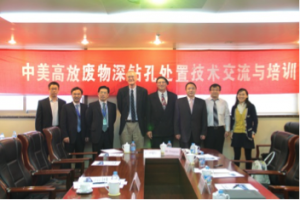Nuclear securitySandia Lab helps China launch nuclear security center
U.S. national labs and their Chinese counterparts have launched the Chinese Center of Excellence (COE) for nuclear security. The center will provide training for security personnel in China’s expanding nuclear power sector. Sandia notes that its experience in physical security grew out of decades of work securing high-consequence facilities against theft and sabotage.

Sandia lab training their Chinese counterparts in nuclear security r // Source: sandia.gov
U.S. Secretary of Energy Ernest Moniz, National Nuclear Security Administration (DOE/NNSA) Principal Deputy Administrator Madelyn Creedon, Sandia National Laboratories President and Labs Director Jill Hruby, and other experts and international guests joined with leaders of China on 18 March to commission the Chinese Center of Excellence (COE) for nuclear security.
The center will provide training for security personnel in China’s expanding nuclear power sector.
“I am honored to represent Sandia at this auspicious occasion,” Hruby said. “We look forward to continuing our collaboration with colleagues at the Center of Excellence to promote nuclear security best practices in China and across the region.”
Sandia Lab reports that DOE/NNSA and the China Atomic Energy Authority agreed to establish the center in a memorandum of understanding signed in 2010. Led by DOE/NNSA, Sandia along with three other national laboratories — Los Alamos National Laboratory in Los Alamos, New Mexico; Oak Ridge National Laboratory in Oak Ridge, Tennessee; and Pacific Northwest National Laboratory in Richland, Washington — and the Department of Defense’s Defense Threat Reduction Agency contributed equipment and expertise crucial to the design and development of the center.
The Sandia Labs team consulted with the Chinese State Nuclear Security Technology Center (SNSTC) on the design, operation, and testing of a physical protection system at a mock material processing nuclear facility at the COE for the proper handling and storage of special nuclear material.
Sandia will also support the future success of the center through the design of nuclear security curriculum to train China’s security professionals how to protect nuclear facilities and materials. The work is part of Sandia’s global security work to enhance security through partnerships that build a capacity worldwide to prevent the misuse of nuclear, chemical, biological and radiological materials.
“It’s in our national interest that everybody’s nuclear materials are secure,” said Nick Winowich, a civil engineer at Sandia. “We want to share our expertise in securing nuclear facilities and materials.”
Performance-based design protects facilities
Sandia notes that its experience in physical security grew out of decades of work securing high-consequence facilities against theft and sabotage. Used across the DOE enterprise and by other U.S. and international agencies, performance–based design specifically defines a facility’s characteristics, vulnerabilities, and all the potential security risks, including an adversary’s capabilities. Its central concept ensures that the time intruders need to steal materials or sabotage a facility exceeds the time responders need to stop them in a fully integrated system.
Equipped with that analysis, Sandia say it designs physical protection systems which are customized to meet a specific facility’s needs.
According to Sandia employees, the lab and its counterparts at the China SNSTC developed a cooperative working relationship which will continue to support nuclear security and nonproliferation in the region long after the opening of the center.
